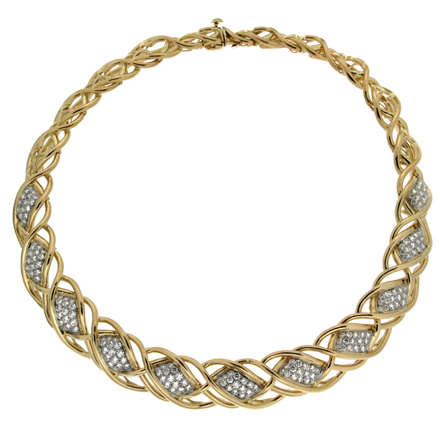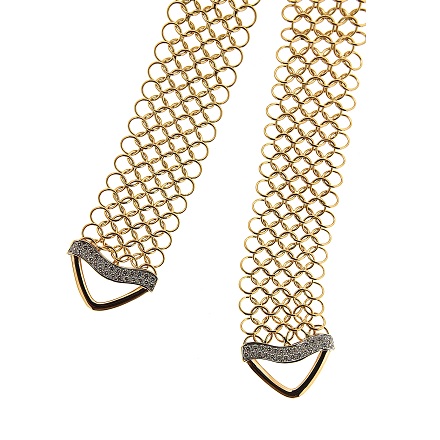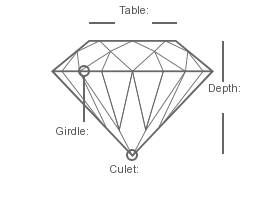Diamonds are admired for their brilliance, durability and romantic symbolism. They appear on every imaginable type of jewelry, from bracelets to tiaras. Diamond rings in particular are exchanged between couples as a sign of enduring love. The association with diamond rings and romance is so strong people may feel pressure to find the best possible jewel. While there is no one diamond that’s suitable for all, there are ways to find the ideal stone for you and your loved one.
 The Gemological Institute of America’s 4Cs of diamonds was developed to help gemologists, jewelers and laypeople alike understand the components that contribute to diamond quality. Cut, color, clarity and carat and their grading scales were designed to be as objective and easily understood as possible, while covering the major components of a diamond’s beauty. Having a basic knowledge of the 4Cs can guide your choice of jewel.
The Gemological Institute of America’s 4Cs of diamonds was developed to help gemologists, jewelers and laypeople alike understand the components that contribute to diamond quality. Cut, color, clarity and carat and their grading scales were designed to be as objective and easily understood as possible, while covering the major components of a diamond’s beauty. Having a basic knowledge of the 4Cs can guide your choice of jewel.
“Cut” refers to how well a diamond is faceted. Stones are graded on a scale from Excellent to Poor, with the ideal being a blend of symmetry, proportion, brilliance and polish. Color measures the degree of tint in a diamond using a range of D to Z. Jewels with a grade of D have the least amount of hue while Z diamonds are visibly brown or yellow. Some people may prefer the subtler play of brilliance on a diamond rated Good, or enjoy a jewel with a mild touch of color.
Clarity measures the quirks in a diamond. They form under volatile conditions, which can leave behind visible marks such as cloudy patches or grain lines. The size, number, location and type of clarity characteristics are evaluated and measured on a scale of eleven ratings ranging from Flawless to Included 3. Carat is used to gauge a diamond’s size via its weight. Larger stones are rarer than smaller ones, leading to an increase in demand as well as value.
Those who want to be certain of a diamond’s quality may wish to look at certified diamonds. Independent third party laboratories such as the Gemological Institute of America can attest to a jewel’s 4Cs and provide verification in the form of reports. GIA certified diamonds have their traits explained in detail, along with diagrams outlining the jewel’s proportions and the location and types of clarity characteristics. Every diamond certified by GIA has a unique report number, allowing for easy reference.
Another factor to consider is the type of diamond cut. Most cuts fall under the categories of brilliant, step, mixed and fancy. Brilliant cut diamonds are designed to take in and reflect as much light as possible, creating a glittering jewel. Step cut diamonds place a greater emphasis on underscoring the stone’s clarity and luster. Mixed cuts aim to provide brilliance while preserving as much carat weight as possible. Fancy cuts are diamonds fashioned into whimsical shapes such as hearts, pears, marquises and more.
The best person to know what diamond is right for you, is yourself. Some people may prefer diamonds with high clarity grades while others enjoy the look of smaller diamonds or find Z color diamonds beautiful. Grades and guidelines can only suggest which diamonds to choose. In the end, it’s your taste that matters.
Tiny Diamonds
Natural diamonds form under intense conditions within the earth. The result is a jewel of unrivaled hardness and refraction. The same environment which creates diamonds make it difficult for larger jewels to take shape. This is reflected in the demand for diamonds with greater carat weight, where a gemstone weighing one carat has a higher value than two half carat jewels. However, smaller diamonds have their own appeal, and are frequently used in jewelry.
 Baguette cut diamonds are narrow rectangular diamonds. They are step cut with concentric facets and an emphasis on luster rather than brilliance. Most baguette cut diamonds are small and used to highlight larger jewels, or mounted with other baguettes to create geometric designs. Mounting styles vary, from prong or bezel settings to channel mounts.
Baguette cut diamonds are narrow rectangular diamonds. They are step cut with concentric facets and an emphasis on luster rather than brilliance. Most baguette cut diamonds are small and used to highlight larger jewels, or mounted with other baguettes to create geometric designs. Mounting styles vary, from prong or bezel settings to channel mounts.
Pave set diamonds are mounted close together, giving the impression that the jewelry is paved with gems. The diamonds of choice for this setting are little round diamonds, adding brilliance and allowing the pave to fit in corners, edges and other places that might be challenging for larger stones. Pave settings are a popular way to cover jewelry with brilliance and frame other jewels in the piece.
Micro pave settings use even finer diamonds for sparkle. These jewels measure the smallest fraction of a carat, and may be mounted with the aid of a microscope. One of the greatest differences between pave and micro pave aside from carat is the greater emphasis of uniform size for micro pave diamonds.
Different regions are known for specializing in cutting certain types of diamonds, known as cutting centers. From the 1970s onward, India gained recognition as a cutting center for the smallest diamonds. Even jewels weighing hundredths of a carat can be fashioned into round brilliant cuts. While the country has since expanded into other aspects of diamond cutting, this specialty remains.
Romantic Diamonds
For centuries, diamonds were used to symbolize love. Those who could afford them exchanged diamond rings with their beloveds as tokens of devotion. As the jewel became more available, more people were able to share rings with their loved ones. Diamonds are also romantic in the sense of invoking ideas of beauty, prestige, adventure and other qualities.
The first known diamond engagement ring was gifted in 1477. Archduke Maximillian of Austria used the hardness of diamonds to signify his enduring love for his fiancé, Mary of Burgundy. His gift started a custom of European elite exchanging diamond engagement rings. Over the centuries, diamond rings as a symbol of romance spread. As availability grew, people from all walks of life exchanged diamond rings to commemorate marriage, wedding anniversaries, and other occasions of love.
Diamonds have been used for thousands of years to create impressive jewelry, particularly to convey romance through a sense of power and awe. Diamonds, especially those famed for their size and color, are mounted onto crown jewels and worn for special ceremonies. Stars such as Elizabeth Taylor also wear unusual diamonds as an expression of glamour.
Within diamonds there may be clarity characteristics which add to their appeal. Some may appear to be random features, like a pinpoint or etch line, while others take on whimsical images. A cloud that resembles a Venetian mask may appeal to a connoisseur’s sense of adventure, while the sentimental minded may enjoy a jewel with a heart shaped crystal.
How the diamond is set can also influence the feelings they instill in the wearer. Those who enjoy displays of bright light may be prefer a brilliant cut diamond mounted on precious metal polished to a mirror sheen. Others may like the sparkle halos add to their ring, or the lines of cathedral or trellis settings. The romance of diamonds and diamond rings depend on appealing to their wearer, with ideal features boiling down to personal taste.
Diamond Girdles
The outermost perimeter of a diamond is known as a girdle. It follows the shape of the stone, taking on a circular form with round diamonds, square with princess cut diamonds, and so on. How the girdle is shaped depends on the cut and what specific standards advise. The way a girdle is fashioned can influence the final appearance of a diamond, including how it’s mounted.
One of the most apparent uses for a diamond girdle is its role in settings. A majority of mounts depend on precious metal gripping the girdle in order to keep the jewel secure. Prong style settings accomplish this with wires which hold onto portions of the girdle. Bezel mounts use strips of metal wrapped around the girdle’s perimeter, and tension use notches cut into the band to hold the girdle.
The thickness of the girdle can influence the final appearance of the diamond. A very thin girdle may be prone to accidental cracks or chipping, leading to a cloudy haze along the edge of the jewel. Girdles that are overly deep may lead to a gemstone that is not as brilliant as it could be. At the same time, making a girdle on the thick side may add to a jewel’s carat, adding value.
With advancements in laser technology, diamond girdles can serve as discrete sources of information. Laboratories such as the Gemological Institute of America provide the option to inscribe their graded diamonds with unique identification numbers on the girdle, where it’s less likely to be noticed. Other places may offer related services for inscribing diamond girdles, writing messages on the jewel which make the diamond even more special to its wearer.
Round Brilliant Facets
The round brilliant cut diamond made its debut in 1919 as the product of a doctoral dissertation. This paper, Diamond Design, outlined the shape, proportions and facets that would give diamonds then unprecedented brilliance. When looking at diamonds, one may hear about tables, crowns, pavilions and other things that may not be immediately clear. Learning about facet names may clear up confusion.
 The table is the flat plain on the uppermost part of the diamond. Most settings are designed to that the table is displayed when the diamond is mounted. In brilliant cut diamonds, cutters try to shape the stone so that light both enters and exits through the table. This way, light reaches the eye of the viewer and makes the stone appear bright.
The table is the flat plain on the uppermost part of the diamond. Most settings are designed to that the table is displayed when the diamond is mounted. In brilliant cut diamonds, cutters try to shape the stone so that light both enters and exits through the table. This way, light reaches the eye of the viewer and makes the stone appear bright.
The crown is the upper half of the diamond, located above the jewel’s outermost perimeter, or girdle. Aside from the table, it contains three separate facet types. Star facets directly border the table, which in turn are surrounded by kite facets. Between the kite facets and the girdle are upper girdle facets. In most round brilliants, there are sixteen upper girdle facets, as well as eight stars and eight kites each.
Below the girdle is the pavilion. Instead of forming a ring around a central facet like with the crown, pavilion facets slope from the girdle to the bottom of the diamond. The pavilion has sixteen triangular facets known as lower girdle facets. There are also eight kite shaped facets known as main pavilion facets.
The last facet on a round brilliant cut diamond is optional. Culets are at the very bottom of a gemstone. While they may be integral to some cut designs, such as emerald cuts, on round brilliant cut diamonds culets serve less of an aesthetic purpose and more of a practical one. By turning a narrow tip into a flat facet, the diamond becomes less vulnerable to chipping.
Fancy diamond shapes
Fancy cut diamonds get their name from their uncommon outlines. Rather than being round, square or rectangular, they have less conventional forms such as lozenges or pears. They can be cut for brilliance, to highlight clarity or be a mixed cut that blends brilliant and step cut facets. Some fancy cuts are more common than others, but all are worth taking a look at.
Kite shaped diamonds have a four-sided outline reminiscent of the flying toy. These jewels are often brilliant cut with pointed corners, and need to be carefully set to prevent accidental chipping. When elongated, kites serve as side stones for rings. They may also be used as central gemstones for rings, pendants and other jewelry.
Shield shaped diamonds have a five-sided outline, resembling a triangle with two cropped corners. Common variants include those with straight sides or slightly curved. Shield diamonds are most often used as side stones on rings, though they are also used as hanging elements on earrings and pendants.
Lozenge shaped diamonds have an outline akin to an octahedral rough diamond, that of two triangles connected at their base. In some groups, these jewels may be called “diamond shaped,” though the term “lozenge” reduces confusion. There are subtle variations to these gemstones, which may have pointed tips or cropped corners. These jewels may be found as central stones in rings and other jewelry.
Triangular diamonds have three sides, three corners and multiple variations. One style of triangular diamonds is brilliant cut, and may be referred to as a trilliant. Another kind is step cut triangular diamonds, which emphasizes the geometric lines of the jewel. They may also have straight edges or slightly curved ones. Triangular diamonds are used as both central jewels and side stones.
Heart shaped diamonds are a popular choice for the romantic minded. Making heart shaped diamonds is complex, with many factors needed to help them look their best. Symmetry is important, as is making sure the stone is neither too wide nor too narrow. Hearts that are gently curved rather than having flattened edges are also considered more pleasing to the eye. These diamonds are most often used as central stones in rings, pendants, earrings and other pieces.
Pear shaped diamonds are typically brilliant cut gems with a rounded end and a pointed tip akin to a teardrop. They’re versatile jewels are used as side stones, central jewels, and hanging elements in pieces like pendants and earrings. When mounted on rings as central stones, they’re often set with the point facing the fingertip to elongate the finger.
Marquise diamonds are oval shaped jewels with pointed tips rather than rounded ends. They were developed in the mid-1700s for the French court, and are said to be modeled off of the Marquise de Pompadour’s lips, leading to their name. The preferred proportions of this cut is twice as long as it is wide, giving it an elongated appearance. They appear as both side stones and central jewels, with gently curving sides and defined tips as recommended features.
Half-moon diamonds resemble round diamonds cut in half, leaving a flat edge. They’re usually brilliant cut jewels, but may also be fashioned as step cut diamonds. Half-moon diamonds often come in pairs, cut to mirror one another. Crescent shaped diamonds are similar to half-moons, but are more bow shaped. Both diamond cuts are favored as side stones.
Diamond Certification Tips
While looking for diamonds or diamond jewelry, a person may be unsure of the quality of the jewels they’re considering. Some may receive advice about focusing their search on certified diamonds, but be unsure where to start. Terminology on the reports may be unfamiliar, and deciding which organization’s certified to select may be confusion. Fortunately, there are guidelines to finding certified diamonds from reliable sources.
Diamond certification is a record stating that the jewel has been examined and has certain, verifiable qualities. Depending on the type of report, these traits may be explained in detail, and possibly supplemented with illustrations. An ideal certificate should have terminology that’s readily understood, with objective descriptions. Certification should not be confused with appraisal, which determines the market value, not the characteristics, of a jewel.
Consider certified diamonds graded by independent third party laboratories. Their evaluations are less likely to be influenced by buyers or sellers. Not every laboratory is created equal, so it’s best to look for those with a strong reputation for excellence. The Gemological Institute of America is one such organization, which has created widely recognized grading standards used to this day.
Diamond certificates should have the jewel’s, carat, color, clarity and cut graded, with an explanation of what the ratings mean. The report should also be able to verify that it is in fact a diamond, and determine whether the jewel is natural or made in a laboratory. Some laboratories will have separate reports for natural and synthetic jewels. More detailed certificates may have pictures of the stone, or diagrams which outline the location of clarity characteristics.
Many diamonds are certified. Be they Z color, Internally Flawless or Good Cut, it’s not just perfect or modest diamonds that are evaluated. Reports can show a range of verifiable qualities along with identification numbers to connect the certificate to the jewel in question. While certification can help people decide which diamonds they desire, it’s up to the connoisseur to make the final choice.





